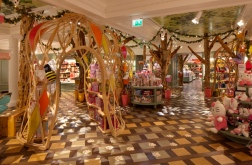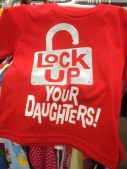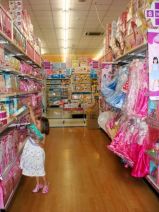 Harrods–an internationally renowned department store in London–has changed the ways in which children encounter toys in the store. Rather than creating gender-specific areas and aisles, they have elected to group toys thematically. Harrods is calling it their “first gender-neutral toy department.” It’s interesting and wonderful to think that feminist critiques of toy store segregation might possibly be behind this move. I think it probably has much more to do with creating a children’s “fun zone” where you don’t realize that you’re actually shopping–though everything’s for sale. It did cause me to pause though and think about what the heck “gender-neutral” actually means.
Harrods–an internationally renowned department store in London–has changed the ways in which children encounter toys in the store. Rather than creating gender-specific areas and aisles, they have elected to group toys thematically. Harrods is calling it their “first gender-neutral toy department.” It’s interesting and wonderful to think that feminist critiques of toy store segregation might possibly be behind this move. I think it probably has much more to do with creating a children’s “fun zone” where you don’t realize that you’re actually shopping–though everything’s for sale. It did cause me to pause though and think about what the heck “gender-neutral” actually means.
My son–Ciaran–was born on April 4, 2011. Preparing for a child was an interesting process. Even before you start trying, you start reading (and there is NO shortage of material), and–if you live in the U.S.–you develop your “parenting philosophy.” This encompasses things like what research you support, agree with, or choose to acknowledge; whether you’ll be breastfeeding and for how long; whether you’ll allow your child to “cry it out” at night; and much much more. Lots of new parents think about gender. It’s something about which we thought a great deal. It’s not that we don’t want Ciaran to have a gender, or to be gendered, or even that we think that’s possible. But, we wanted to control some of the ways in which gender (as an organizing principle in the world around him) was introduced to him on a daily basis.
This issue becomes particularly important if you will need or want to rely on family and friends to help you buy some of the things you acquire when having a baby. Certainly clothing is gendered, but so are pacifiers, baby carriers, bottles, strollers, car seats, teething rings, crib sheets, mobiles, children’s books, most of children’s media (if you use it), toys, sleeping sacks, diaper bags, and more.
We responded in a way that I’m guessing is typical of many couples like us when asked, “So, what can we get for you?” We ended up sprinkling the phrase “gender neutral” into lots of those early conversations.
 There’s actually a bit of “gender-neutral” clothing options available at most children’s stores now for infants–though around the 18 months and older mark, these options are in shorter supply. Marketers know that parents (at least some of us) are looking for clothing that is somehow devoid of gender (or better said, devoid of certain styles of gender). Most parents who look for “gender-neutral” clothes simply don’t want to put their sons in
There’s actually a bit of “gender-neutral” clothing options available at most children’s stores now for infants–though around the 18 months and older mark, these options are in shorter supply. Marketers know that parents (at least some of us) are looking for clothing that is somehow devoid of gender (or better said, devoid of certain styles of gender). Most parents who look for “gender-neutral” clothes simply don’t want to put their sons in  onesies that say “lady killer” or “lock up your daughters.” Or they don’t want to put their daughters in ballerina costumes before they are even walking. So, “gender-neutral” clothing is actually probably better understood as clothing that avoids very specific gendered stereotypes that are present on the vast majority of children’s clothing.
onesies that say “lady killer” or “lock up your daughters.” Or they don’t want to put their daughters in ballerina costumes before they are even walking. So, “gender-neutral” clothing is actually probably better understood as clothing that avoids very specific gendered stereotypes that are present on the vast majority of children’s clothing.
It’s also true that many parents walk a fine line as parents are perhaps equally if not more likely to heavily police gender nonconformity among their children–particularly fathers (see Emily Kane’s work here).  Other parents of gender variant children must continually account for their children’s performances of gender as we do not live in a gender-neutral world (see Tey Meadow’s work here). And children often have less of a problem with gender variance among their peers than do parents. This idea was really shockingly illustrated by a blog post about a boy who chose to dress up as Daphne from Scooby-Doo for Halloween and other parents’ reactions (here).
Other parents of gender variant children must continually account for their children’s performances of gender as we do not live in a gender-neutral world (see Tey Meadow’s work here). And children often have less of a problem with gender variance among their peers than do parents. This idea was really shockingly illustrated by a blog post about a boy who chose to dress up as Daphne from Scooby-Doo for Halloween and other parents’ reactions (here).
What “gender-neutral” meant for us–at least initially–was that Ciaran found himself dressed in a lot of yellow and green (the “gender-neutral” colors de jour at most big children’s clothing stores). It also meant that Ciaran had a more limited set of cuddly animals and images on his clothes. Certain animals and images are often on baby girl clothes (like butterflies, unicorns, horses, hearts, rainbows, and cats) while others are more common on baby boy clothes (like dogs, cars, trucks, sharks, whales, lions, tigers, and bears… oh my!). The image that gender-neutral clothing was able to really stake a claim to was the duck. I’d say 60% of Ciaran’s clothes (including pajamas, baby bathrobes, slippers, hats, and socks) were duck-themed. During the sleepless nights, there were a couple of days I think I mistook Ciaran for a duck.
Gap’s recent gender-neutral line featured a series of woodland animals less present on most children’s clothing, and thus, less easily identified as intended for boys or girls. They featured things like hedgehogs, foxes, owls, and more. Cute stuff, but it’s not cheap.
 Toy stores are often worse. When I ask students to think about gender socialization, when it happens, how, and where, the “pink aisle” in toy stores is often brought up as an example. Children are really wonderful for the sociological imagination. They help to remind us that the ways we categorize and understand the world around us is the result of incredible cooperation. A recent video went viral of a young girl–Riley–explaining to her father how ridiculous gender segregation of space in toy stores is and how it promotes specific interests while denying others (here).
Toy stores are often worse. When I ask students to think about gender socialization, when it happens, how, and where, the “pink aisle” in toy stores is often brought up as an example. Children are really wonderful for the sociological imagination. They help to remind us that the ways we categorize and understand the world around us is the result of incredible cooperation. A recent video went viral of a young girl–Riley–explaining to her father how ridiculous gender segregation of space in toy stores is and how it promotes specific interests while denying others (here).
The notion of gender neutrality expresses the belief that we ought to avoid distinguishing between people based on their gender to avoid discrimination. Of course, this kind of discrimination happens all the time. When we casually assume that individuals are somehow “better suited” to certain tasks, jobs, activities, etc. because of their gender, we’re discriminating. When those assumptions are codified into law, informal or formal, it’s legally actionable. Pushes for gender neutrality have produced some interesting changes in social life. At a basic level, job titles have been altered to not presume the gender of the occupant (stewardesses are now flight attendants, policemen are now police officers, the garbage man is now a waste disposal engineer, and so on). But the notion of gender neutrality is also behind support for same-sex marriage based on the belief that we should not limit the roles of marital partners based on gender. The idea of gender neutrality has subtly changed a great deal in social life, but my sense is, like Harrods, this “transformation” is only skin deep. While we now refer to stewardesses as “flight attendants,” it’s also true that the job remains disproportionately filled with women and is likely still understood as “feminine” regardless of the gender of an individual attendant.
Calling something a “gender-neutral” space in a department store makes us think about what we mean by gender and how we want our children to come to understand the gendered world in which they will live. Removing the “pink aisle” from a toy store doesn’t get rid of gender. But perhaps moves like this are an important way of culturally authorizing more expansive interests in both girls and boys.

Pingback: Interesting Articles On The Pinkification Of Toys | Lynley Stace
Pingback: Gender Equality | Designing Spaces and Places